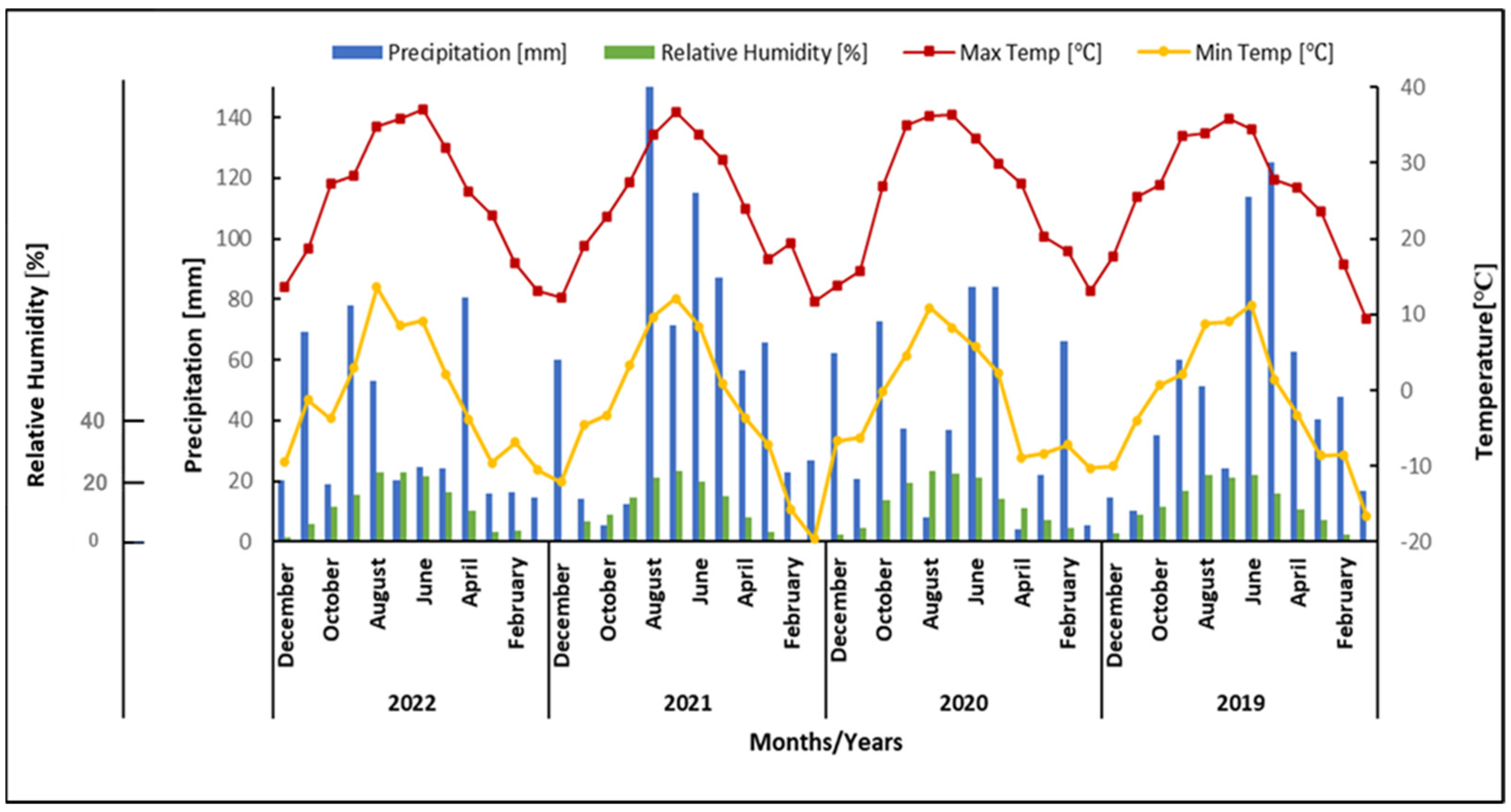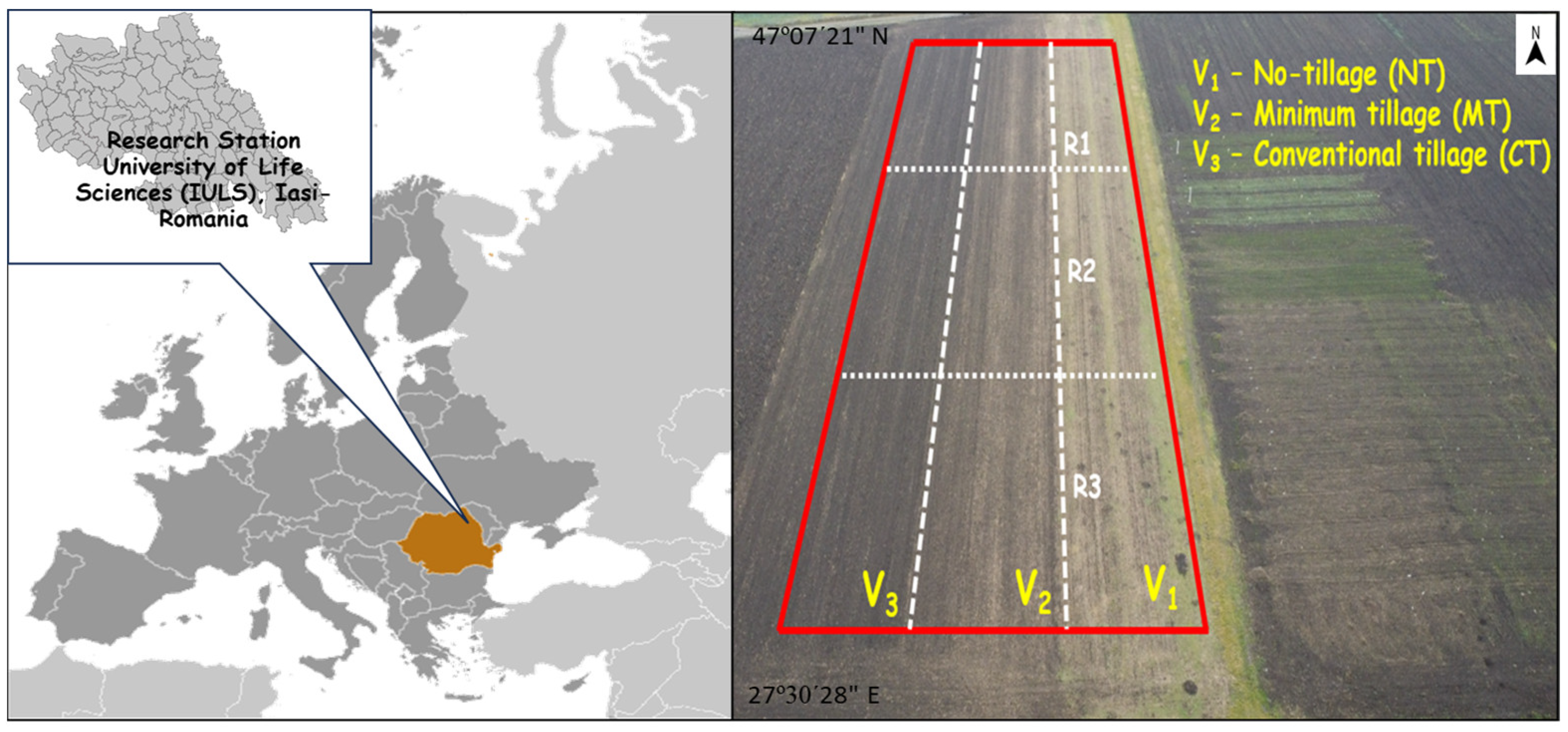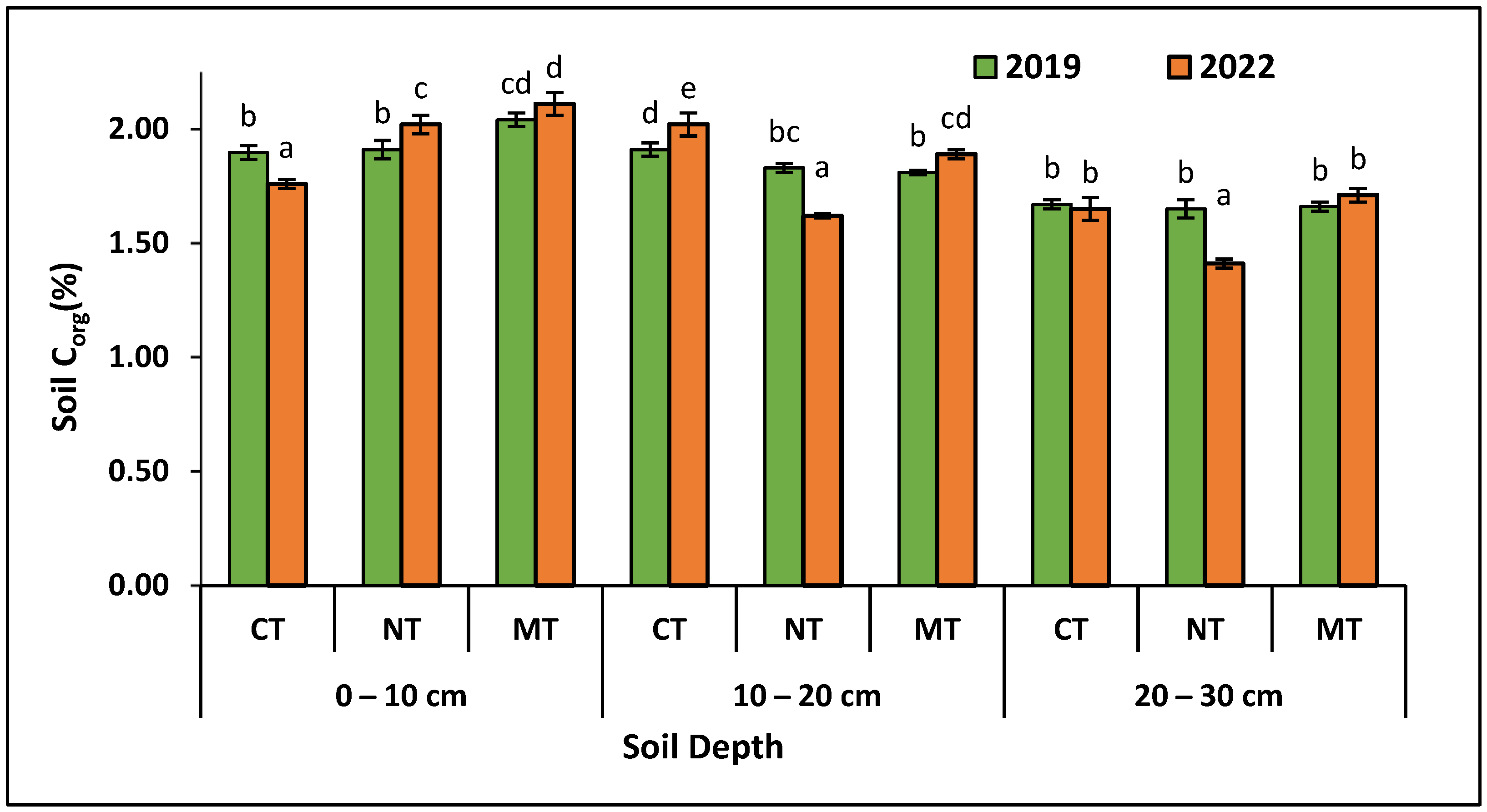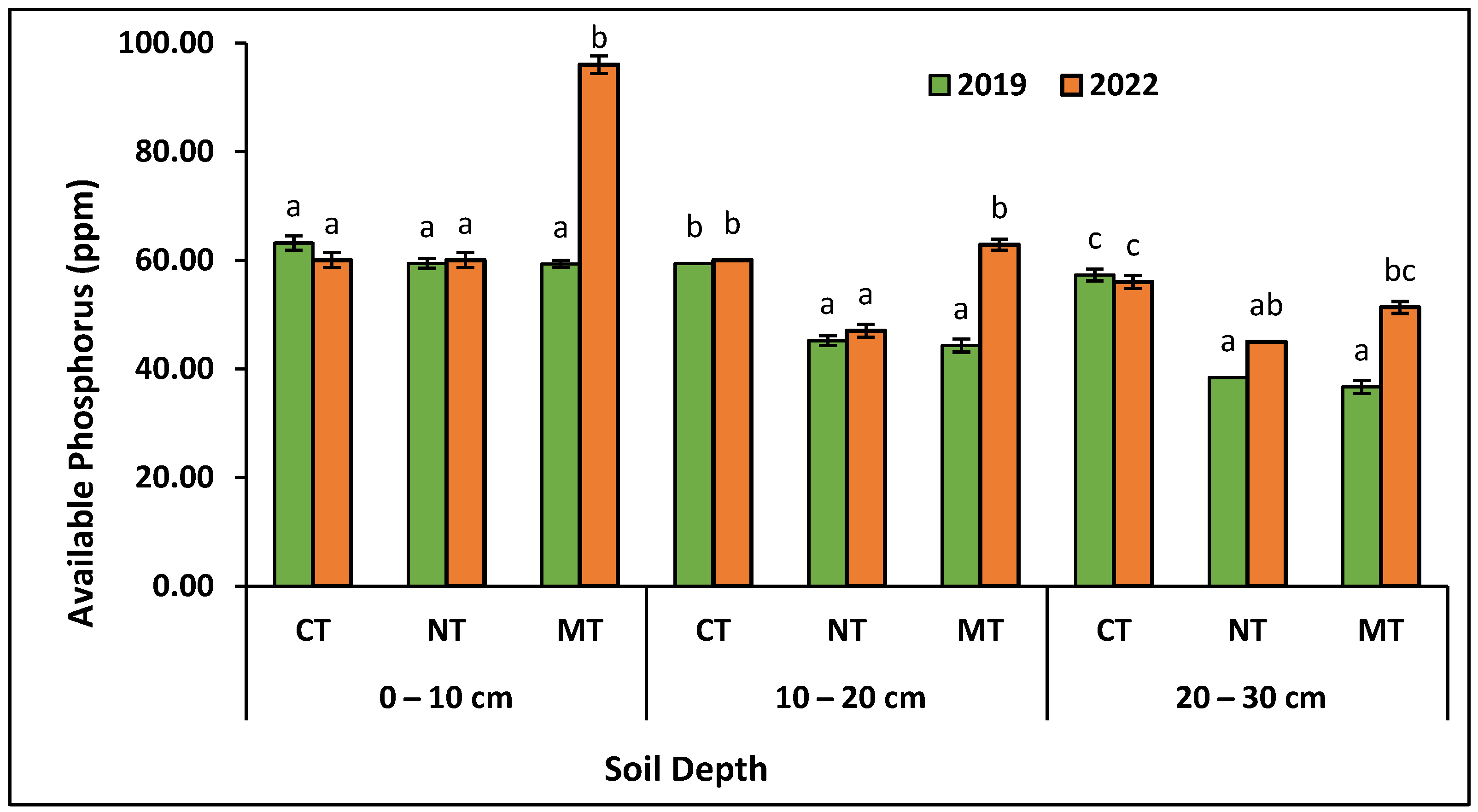Tillage and Straw Management Practices Influences Soil Nutrient Distribution: A Case Study from North-Eastern Romania
Abstract
:1. Introduction
2. Materials and Methods
2.1. Research Site Description
2.2. Tillage Practices and Experimental Design
2.3. Soil Sampling and Analysis
2.4. Statistical Analysis
3. Results and Discussion
3.1. Influence of Tillage System on Soil pH
3.2. Influence of Tillage System on Soil Organic Carbon
3.3. Influence of Tillage System on Soil Available N, P and K
3.4. Influence of Tillage System on Soil Total N, P and K
3.5. Influence of Tillage System on Soil Available and Total Zn, Cu, Fe and Mn
3.6. Correlation of Tillage and Straw Management Practices with Soil Chemical Properties
4. Implication and Limitation of the Study
5. Conclusions
Author Contributions
Funding
Institutional Review Board Statement
Informed Consent Statement
Data Availability Statement
Acknowledgments
Conflicts of Interest
References
- Lv, L.; Gao, Z.; Liao, K.; Zhu, Q.; Zhu, J. Impact of conservation tillage on the distribution of soil nutrients with depth. Soil Till. Res. 2023, 225, 105527. [Google Scholar] [CrossRef]
- Ozbolat, O.; Sanchez-Navarro, V.; Zornoza, R.; Egea-Cortines, M.; Cuartero, J.; Ros, M.; Pascual, J.A.; Boix-Fayos, C.; Almagro, M.; de Vente, J.; et al. Long-term adoption of reduced tillage and green manure improves soil physicochemical properties and increases the abundance of beneficial bacteria in a Mediterranean rainfed almond orchard. Geoderma 2023, 429, 116218. [Google Scholar] [CrossRef]
- Tang, M.; Liu, R.; Luo, Z.; Zhang, C.; Kong, J.; Feng, S. Straw returning measures enhances soil moisture and nutrients and promote cotton growth. Agronomy 2023, 13, 1850. [Google Scholar] [CrossRef]
- Celik, I.; Gunal, H.; Acir, N.; Barut, Z.B.; Budak, M. Soil quality assessment to comapare tillage systems in Cukurova Plain, Turkey. Soil Till. Res. 2021, 208, 104892. [Google Scholar] [CrossRef]
- Sadiq, M.; Li, G.; Rahim, N.; Tahir, M.M. Sustainable conservation tillage technique for improving soil health by enhancing soil physicochemical quality indicators under wheat mono-cropping system conditions. Sustainability 2021, 13, 8177. [Google Scholar] [CrossRef]
- Li, Y.; Hu, Y.; Song, D.; Liang, S.; Qin, X.; Siddique, K.H.M. The effects of straw incorporation with plastic films mulch on soil properties and bacterial community structures on the Loess Plateau. Eur. J. Soil Sci. 2021, 72, 979–994. [Google Scholar] [CrossRef]
- Mausel, P.W. Soil quality in Illinois—An example of a soil geography resource analysis. Prof. Geogr. 1971, 23, 127–136. [Google Scholar] [CrossRef]
- Bunemann, E.K.; Bongiorno, G.; Bai, Z.; Creamer, R.; De Deyn, G.; de Goede, R.; Fleskens, L.; Geissen, V.; Kuyper, T.w.; Mader, P.; et al. Soil quality—A critical review. Soil Biol. Biochem. 2018, 120, 105–125. [Google Scholar] [CrossRef]
- Nunes, M.R.; Mathijs van Es, H.; Schindelbeck, R.; Ristow, A.J.; Ryan, M. No-till and cropping system diversification improve soil health and crop yield. Geoderma 2018, 328, 30–43. [Google Scholar] [CrossRef]
- Thapa, V.R.; Ghimire, R.; Paye, W.S.; Van Leeuwen, D. Soil organic carbon and nitrogen responses to occasional tillage in a continuous no-tillage system. Soil Till. Res. 2023, 227, 105619. [Google Scholar] [CrossRef]
- Chețan, F.; Rusu, T.; Chețan, C.; Moraru, P.I. Influence of Soil Tillage upon Weeds, Production and Economical Efficiency of Corn Crop. AgroLife Sci. J. 2016, 5, 36–43. [Google Scholar]
- Jat, R.K.; Singh, R.G.; Gupta, R.K.; Gill, G.; Chauhan, B.S.; Pooniya, V. Tillage, crop establishment, residue management and herbicide applications for effective weed control in direct seeded rice of eastern Indo-Gangetic Plains of South Asia. Crop Prot. 2019, 123, 12–20. [Google Scholar] [CrossRef]
- Kassam, A.; Friedrich, T.; Derpsch, R.; Kienzle, J. Overview of the worldwide spread of conservation agriculture. Field Actions Sci. Rep. 2015, 8. [Google Scholar]
- Soane, B.D.; Ball, B.C.; Arvidsson, J.; Basch, G.; Moreno, F.; Roger-estrade, J. No-till in northern, western and southwestern Europe: A review of problems and opportunities for crop production and the environment. Soil Till. Res. 2012, 118, 66–87. [Google Scholar] [CrossRef]
- Holland, J.M. The environmental consequence of adopting conservation tillage in Europe: Reviewing the evidence. Agric. Ecosyst. Environ. 2004, 103, 1–25. [Google Scholar] [CrossRef]
- Achankeng, E.; Cornelis, W. Conservation tillage effects on European crop yields: A meta-analysis. Field Crops Res. 2023, 298, 108967. [Google Scholar] [CrossRef]
- Sharma, P.; Singh, M.K.; Verma, K.; Prasad, S.K. Changes in the weed seed bank in long term establishment methods trials under rice-wheat cropping system. Agronomy 2020, 10, 292. [Google Scholar] [CrossRef]
- Rahman, M.; Aravindakshan, S.; Hoque, M.A.; Rahman, M.A.; Gulandaz, A.; Rahman, J.; Islam, T. Conservation tillage (CT) for climate-smart sustainable intensification: Assessing the impact of CT on soil organic carbon accumulation, greenhouse gas emission and water footprint of wheat cultivation in Bangladesh. Environ. Sustain. Ind. 2021, 10, 100106. [Google Scholar] [CrossRef]
- Huang, T.; Yang, N.; Lu, C.; Qin, X.; Siddique, K.H.M. Soil organic carbon, total nitrogen, available nutrients and yield under different straw returning methods. Soil Till. Res. 2021, 214, 105171. [Google Scholar] [CrossRef]
- Tian, P.; Lian, H.; Wang, Z.; Jiang, Y.; Li, C.; Sui, P.; Qi, H. Effects of deep and shallow tillage with straw incorporation on soil organic carbon, total nitrogen and enzyme activities in northeast China. Sustainability 2020, 12, 8679. [Google Scholar] [CrossRef]
- Rusu, T. Energy efficiency and soil conservation in conventional, minimum tillage and no-tillage. Research 2014, 2, 42–49. [Google Scholar] [CrossRef]
- Malik, A.; Puissant, J.; Buckeridge, K.M.; Goodall, T.; Jehmlich, N.; Chowdhury, S.; Gweon, H.S.; Peyton, M.J.; Mason, K.E.; van Agtmaal, M.; et al. Land use driven change in soil pH affects microbial carbon cycling processes. Nat. Commun. 2018, 9, 3591. [Google Scholar] [CrossRef] [PubMed]
- Mustafa, A.; Minggang, X.; Shah, S.A.A.; Abrar, M.M.; Nan, S.; Baoren, W.; Zejiang, C.; Saeed, Q.; Naveed, M.; Mehmood, K.; et al. Soil aggregation and soil aggregate stability regulate organic carbon and nitrogen storage in a red soil of southern China. J. Environ. Manag. 2020, 270, 110894. [Google Scholar] [CrossRef] [PubMed]
- Dai, W.; Wang, J.; Fang, K.; Cao, L.; Sha, Z.; Cao, L. Wheat straw incorporation affecting soil carbon and nitrogen fractions in chinese paddy soil. Agriculture 2021, 11, 803. [Google Scholar] [CrossRef]
- Liang, A.Z.; Hang, X.P.; Yang, X.M.; Drury, C.F. Short-term effects of tillage on soil organic carbon storage in the plow layer of black soil in northeast China. Sci. Agric. Sin. 2006, 39, 1287–1293. [Google Scholar]
- Obour, A.K.; Holman, J.D.; Simon, L.M.; Schlegel, A.J. Strategic Tillage Effects on Crop Yields, Soil Properties, and Weeds in Dryland No-Tillage Systems. Agronomy 2021, 11, 662. [Google Scholar] [CrossRef]
- Canisares, L.; Grove, J.; Miguez, F.; Poffenbarger, H. Long-term no-till increases soil nitrogen mineralization but does not affect optimal corn nitrogen fertilization practices relative to inversion tillage. Soil Till. Res. 2021, 213, 105080. [Google Scholar] [CrossRef]
- Vázquez, E.; Benito, M.; Navas, M.; Espejo, R.; Díaz-Pinés, E.; Teutscherova, N. The interactive effect of no-tillage and liming on gross N transformation rates during the summer fallow in an acid Mediterranean soil. Soil Till. Res. 2019, 194, 104297. [Google Scholar] [CrossRef]
- Kumar, A.; Behera, U.K.; Dhar, S.; Shukla, L.; Bhatiya, A.; Meena, M.C.; Gupta, G.; Singh, R.K. Effect of tillage, crop residue and phosphorus management practices on the productivity and profitability of maize cultivation in Inceptisols. J. Agric. Sci. 2018, 88, 182–188. [Google Scholar] [CrossRef]
- Dwivedi, B.S.; Singh, V.K.; Shekhawat, K.; Meena, M.C.; Dey, A. Enhancing use efficiency of phosphorus and potassium under different cropping systems of India. Indian J. Fertil. 2017, 13, 20–41. [Google Scholar]
- Stankowski, S.; Jaroszewska, A.; Osińska, B.; Tomaszewicz, T.; Gibczyńska, M. Analysis of Long-Term Effect of Tillage Systems and Pre-Crop on Physicochemical Properties and Chemical Composition of Soil. Agronomy 2022, 12, 2072. [Google Scholar] [CrossRef]
- Malobane, M.E.; Nciizah, A.; Mudau, F.N.; Wakindiki, I.I.C. Tillage, crop rotation and crop residue management effects on nutrient availability in a sweet sorghum-based cropping system in marginal soils of south Africa. Agronomy 2020, 10, 776. [Google Scholar] [CrossRef]
- Palmer, B.; Guppy, C.; Nachimuthu, G.; Hulugalle, N. Changes in micronutrients concentrations under minimum tillage and cotton-based crop rotations in irrigated vertisols. Soil Till. Res. 2023, 228, 105626. [Google Scholar] [CrossRef]
- Janke, C.; Moody, P.; Fujinuma, R.; Bell, M. The impact of banding polymer-coated urea on nitrogen availability and distribution in contrasting soils. Soil Sci. Plant Nutr. 2022, 22, 3081–3095. [Google Scholar] [CrossRef]
- Topa, D.; Cara, I.G.; Jitareanu, G. Long term impact of different tillage systems on carbon pools and stocks, soil bulk density, aggregation and nutrients: A field meta-analysis. Catena 2021, 199, 105102. [Google Scholar] [CrossRef]
- Yang, Y.; Long, Y.; Li, S.; Liu, X. Straw return decomposition characteristics and effects on soil nutrients and maize yield. Agriculture 2023, 13, 1570. [Google Scholar] [CrossRef]
- Gura, I.; MnKeni, P.N.S.; Du Preez, C.C.; Barnard, J.H. Short-term effects of conservation agriculture strategies on the soil quality of a Haplic Plinthosol in Eastern Cape, South Africa. Soil Till. Res. 2022, 220, 105378. [Google Scholar] [CrossRef]
- Thomas, G.A.; Dalal, R.C.; Standley, J. No-till effects on organic matter, pH, cation exchange capacity and nutrient distribution in a Luvisol in the semi-arid subtropics. Soil Till. Res. 2007, 94, 295–304. [Google Scholar] [CrossRef]
- Stihole, N.J.; Magwaza, L.S.; Mafongoya, P.L. Conservation agriculture and its impact on soil quality and maize yield: Asouth African perspective. Soil Till. Res. 2016, 162, 55–67. [Google Scholar] [CrossRef]
- Li, Y.; Li, Z.; Cui, S.; Jagadamma, S.; Zhang, Q.P. Residue retention and minimum tillage improve physical environment of the soil in croplands: A global meta-analysis. Soil Till. Res. 2019, 194, 104292. [Google Scholar] [CrossRef]
- Githongo, M.; Kiboi, M.; Muriuki, A.; Fliessbach, A.; Musafiri, C.; Ngetich, F.K. Organic carbon content in fractions of soil managed for soil fertility improvement in sub-humid agroecosystems of Kenya. Sustainability 2023, 15, 683. [Google Scholar] [CrossRef]
- Liu, W.S.; Liu, W.X.; Kan, Z.R.; Chen, J.S.; Zhao, X.; Zhang, H.L. Effects of tillage and straw management on grain yield and SOC storage in a wheat-maize cropping system. Eur. J. Agron. 2022, 137, 126530. [Google Scholar] [CrossRef]
- Wang, Y.; Zhang, Y.; Zhou, S.; Wang, Z. Meta-analysis of no-tillage effect on wheat and maize water use efficiency in China. Sci. Total Environ. 2018, 635, 1372–1382. [Google Scholar] [CrossRef] [PubMed]
- Quincke, J.A.; Wortmann, C.S.; Mamo, M.; Franti, T.; Drijber, R.A. Occasional tillage of no-till systems: Carbon dioxide flux and changes in total and labile soil organic carbon. Agron. J. 2007, 99, 1158–1168. [Google Scholar] [CrossRef]
- Zhao, Y.; Wang, M.; Hu, S.; Zhang, X.; Ouyang, Z.; Zhang, G.; Huang, B.; Zhao, S.; Wu, J.; Xie, D.; et al. Economics- and policy-driven organic carbon input enhancement dominates soil organic carbon accumulation in Chinese croplands. Proc. Natl. Acad. Sci. USA 2018, 115, 4045–4050. [Google Scholar] [CrossRef] [PubMed]
- Higo, M.; Tatewaki, Y.; Iida, K.; Yokota, K.; Isobe, K. Amplicon sequencing analysis of arbuscular mycorrhizal fungal communities colonizing maize roots in different cover cropping and tillage systems. Sci. Rep. 2020, 10, 6039. [Google Scholar] [CrossRef] [PubMed]
- Lu, F. How can straw incorporation management impact on soil carbon storage? A meta–analysis. Mitig. Adapt. Strat. Glob. Chang. 2015, 20, 1545–1568. [Google Scholar] [CrossRef]
- Krauss, M.; Wiesmeier, M.; Don, A.; Cuperus, F.; Gattinger, A.; Gruber, S.; Haagsma, W.K.; Peigne, J.; Chiodelli Palazzoli, M.; Schulz, F.; et al. Reduced tillage in organic farming affect soil organic carbon stocks in temperate Europe. Soil Till. Res. 2022, 216, 105262. [Google Scholar] [CrossRef]
- Melero, S.; Lopez-Garrido, R.; Murillo, J.M.; Moreno, F. Conservation tillage short and long term effects on soil carbon fractions and enzymatic activities under Mediterranean conditions. Soil Till. Res. 2009, 104, 292–298. [Google Scholar] [CrossRef]
- Novak, J.M.; Watts, D.W.; Bauer, P.J.; Karlen, D.L.; Hunt, P.G.; Mishra, U. Loamy sand soil approaches organic carbon saturation after 37 years of conservation tillage. Agron. J. 2020, 112, 3152–3162. [Google Scholar] [CrossRef]
- Liu, X.; Shi, Z.; Bai, H.; Zhang, J.; Sun, D.; Chen, Y. Soil carbon sequestration in paddy field and its simultaneous mineralization to supply available nutrients for the crops are affected by no-tillage with straw management: A meta-analysis. Appl. Soil Ecol. 2023, 188, 104850. [Google Scholar] [CrossRef]
- Abdollahi, L.; Munkholm, L.J. Tillage system and cover crop effects on soil quality: I. chemical, mechanical and biological properties. Soil Sci. Soc. Am. J. 2014, 78, 262–270. [Google Scholar] [CrossRef]
- Mloza-Banda, M.L.; Cornelis, W.M.; Mloza-Banda, H.R.; Makwiza, C.N.; Verbist, K. Soil properties after change to conservation agriculture from ridge tillage in sandy clay loams of mid-altitude central Malawi. Soil Use Manag. 2014, 30, 569–578. [Google Scholar] [CrossRef]
- Wang, B.-S.; Cai, D.-X.; Wu, X.-P.; Li, J.; Liang, G.-P.; Yu, W.-S.; Wang, X.-L.; Yang, Y.-Y.; Wang, X.-B. Effects of long-term conservation tillage on soil organic carbon, maize yield and water utilization. J. Plant Nutr. Fert. 2015, 21, 1455–1464. [Google Scholar]
- Powlson, D.S.; Whitmore, A.P.; Goulding, K.W.T. Soil carbon sequestration to mitigate climate change: A critical re-examination to identify the true and the false. Eur. J. Soil Sci. 2011, 62, 42–55. [Google Scholar] [CrossRef]
- Guo, L.J.; Zhang, L.; Liu, L.; Sheng, F.; Cao, C.G.; Li, C.F. Effects of long-term no tillage and straw return on greenhouse gas emissions and crop yields from a rice-wheat system in central China. Agric. Ecosyst. Environ. 2021, 322, 107650. [Google Scholar] [CrossRef]
- Zhang, H.; Wang, D.; Su, B.; Shao, S.; Yang, J.; Fan, M.; Wu, J.; Gao, C. Distribution and determinants of organic carbon and available nutrients in tropical paddy soils revealed by high-resolution sampling. Agric. Ecosyst. Environ. 2021, 320, 107580. [Google Scholar] [CrossRef]
- Page, K.L.; Strong, W.M.; Dalal, R.C.; Menzies, N.W. Nitrification in a Vertisol subsoil and its relationship to the accumulation of ammonium-nitrogen at depth. Aust. J. Soil Res. 2002, 40, 727–735. [Google Scholar] [CrossRef]
- Lopez-Bellido, L.; Munoz-Romero, V.; Lopez-Bellido, R.J. Nitrate accumulation in the soil profile: Long-term effects of tillage, rotation and N rate in a Mediterranean Vertisol. Soil Till. Res. 2013, 130, 18–23. [Google Scholar] [CrossRef]
- Huang, M.; Zhou, X.; Cao, F.; Xia, B.; Zou, Y. No-tillage effect on rice yield in China: A meta-analysis. Field Crops Res. 2015, 183, 126–137. [Google Scholar] [CrossRef]
- Wei, K.; Chen, Z.H.; Zhang, X.P.; Liang, W.J.; Chen, L.J. Tillage effects on phosphorus composition and phosphatase activities in soil aggregates. Geoderma 2014, 217–218, 37–44. [Google Scholar] [CrossRef]
- Tiecher, T.; Gomes, M.V.; Ambrosini, V.G.; Amorim, M.B.; Bayer, C. Assessing linkage between soil phosphorus forms in contrasting tillage systems by path analysis. Soil Till. Res. 2018, 175, 276–280. [Google Scholar] [CrossRef]
- Sousa, D.M.G.; Volkweiss, S.J. Efeito Residual do superfosfato triplo aplicado em po e em granulos no solo. Rev. Bras. Cienc. Solo. 1987, 11, 141–146. [Google Scholar]
- Yan, J.; Jiang, T.; Yao, Y.; Lu, S.; Wang, Q.; Wei, S. Preliminary investigation of phosphorus adsorption onto two types of iron oxide-organic matter complexes. J. Environ. Sci. 2016, 42, 152–162. [Google Scholar] [CrossRef] [PubMed]
- Lozier, T.M.; Macrae, M.L.; Brunke, R.; Van Eerd, L.L. Release of phosphorus from crop residue and cover crops over the non-growing season in a cool temperate region. Agric. Water Manag. 2017, 189, 39–51. [Google Scholar] [CrossRef]
- Wulanningtyas, H.P.; Gong, Y.; Li, P.; Sakagami, N.; Nishiwaki, J.; Komatsuzaki, M. A cover crop and no-tillage system for enhancing soil health by increasing soil organic matter in soybean cultivation. Soil Till. Res. 2021, 205, 104749. [Google Scholar] [CrossRef]
- Sepat, S.; Rai, R.K. Effect of phosphorus levels and sources of productivity, nutrient uptake and soil fertility of maize (Zea Mays)-wheat (Triticum aestivum) cropping system. Indian J. Agron. 2013, 58, 292–297. [Google Scholar] [CrossRef]
- Boudiar, R.; Alshallash, K.S.; Alharbi, K.; Okasha, S.; Fenni, M.; Mekhlouf, A.; Fortas, B.; Hamsi, K.; Nadjem, K.; Belagrouz, A.; et al. Influence of tillage and cropping systems on soil properties and crop performance under semi-arid conditions. Sustainability 2022, 14, 11651. [Google Scholar] [CrossRef]
- Pavinato, P.S.; Dao, T.H.; Rosolem, C.A. Tillage and phosphorus management effects on enzyme-labile bioactive phosphorus availability in Cerrado Oxisols. Geoderma 2010, 156, 207–215. [Google Scholar] [CrossRef]
- Jat, H.S.; Datta, A.; Sharma, P.C.; Kumar, V.; Yadav, A.K.; Choudhary, M.; Choudhary, V.; Gathala, M.K.; Shama, D.K.; Jat, M.L.; et al. Assessing soil properties and nutrient availability under conservation agriculture practices in a reclaimed sodic soil in cereal based system of North-West India. Arch. Agron. Soil Sci. 2018, 64, 531–545. [Google Scholar] [CrossRef] [PubMed]
- Stellacci, A.M.; Castellinni, M.; Diacono, M.; Rossi, R.; Gattullo, C.E. Assessment of Soil Quality under different soil management strategies: Combined use of statistical approaches to select the most informative soil physico-chemical indicators. Appl. Sci. 2021, 11, 5099. [Google Scholar] [CrossRef]
- Zahid, A.; Ali, S.; Ahmed, M.; Iqbal, N. Improvement of soil health through residue management and conservation tillage in rice-wheat cropping system of Punjab, Pakistan. Agronomy 2020, 10, 1844. [Google Scholar] [CrossRef]
- Raus, L.; Jitareanu, G.; Ailincăi, C.; Parvan, L.; Topa, D. Impact of different soil tillage systems and organo-mineral fertilization on physical properties of the soil and on crop yield in pedoclimatical conditions of Moldavian plateau. Rom. Agric. Res. 2016, 33, 111–123. [Google Scholar]
- Fiorini, A.; Boselli, R.; Maris, S.C.; Santelli, S.; Ardenti, F.; Capra, F.; Tabaglio, V. May conservation tillage enhance soil C and N accumulation without decreasing yield in intensive irrigated croplands? Results from an eight-year maize monoculture. Agric. Ecosyst. Environ. 2020, 296, 106926. [Google Scholar] [CrossRef]
- Omara, P.; Aula, L.; Oyebiyi, F.; Nambi, E.; Dhillon, J.S.; Carpenter, J.; Raun, W.R. No tillage improves winter wheat (Triticum aestivum L.) grain nitrogen use efficiency. Commun. Soil Sci. Plant Anal. 2019, 50, 2411–2419. [Google Scholar] [CrossRef]
- Mondal, S.; Chakraborty, D. Soil nitrogen status can be improved through no-tillage adoption particularly in the surface soil: A global meta-analysis. J. Clean. Prod. 2022, 366, 132874. [Google Scholar] [CrossRef]
- Ladha, J.K.; Jat, M.L.; Stirling, C.M.; Chakraborty, D.; Pradhan, P.; Krupnik, T.J.; Sapkota, T.B.; Pathak, H.; Rana, D.S.; Tesfaye, K.; et al. Chapter two: Achieving the sustainable development goals in agriculture: The crucial role of nitrogen in cereal-based systems. Adv. Agron. 2020, 163, 39–116. [Google Scholar] [CrossRef]
- Jenkinson, D.S.; Coleman, K. The turnover of organic carbon in subsoils. Part 2. Modelling carbon turnover. Eur. J. Soil Sci. 2008, 59, 400–413. [Google Scholar] [CrossRef]
- Xue, J.F.; Pu, C.; Liu, S.L.; Chen, Z.D.; Chen, F.; Xiao, X.P.; Lal, R.; Zhang, H.L. Effects of tillage systems on soil organic carbon and total nitrogen in a double paddy cropping system in Southern China. Soil Till. Res. 2015, 153, 161–168. [Google Scholar] [CrossRef]
- Parajuli, B.; Ye, R.; Luo, M.; Ducey, T.F.; Park, D.; Smith, M.; Sigua, G. Contrasting carbon and nitrogen responses to tillage at different soil depths: An observation after 40-year of tillage management. Soil Sci. Soc. Am. J. 2021, 85, 1256–1268. [Google Scholar] [CrossRef]
- Piegholdt, C.; Geisseler, D.; Koch, H.J.; Ludwig, B. Long term tillage effects on the distribution of phosphorus fractions of loess soils in Germany. J. Plant Nutr. Soil Sci. 2013, 176, 217–226. [Google Scholar] [CrossRef]
- Lupwayi, N.Z.; Calyton, G.W.; O’Donovan, J.T.; Harker, K.N.; Turkington, T.K.; Soon, Y.K. Phosphorus release during decomposition of crop residues under conventional and zero tillage. Soil Till. Res. 2007, 95, 231–239. [Google Scholar] [CrossRef]
- Messiga, A.J.; Ziadi, N.; Morel, C.; Grant, C.; Tremblay, G.; Lamarre, G.; Parent, L.E. Long term impact of tillage practices and biennial P and N fertilization on maize and soybean yields and soil P status. Field Crops Res. 2012, 133, 10–22. [Google Scholar] [CrossRef]
- Grove, J.H.; Ward, R.C.; Weil, R.R. Nutrient stratification in no-till soils. Science 2016, 6, 374–381. [Google Scholar]
- Wright, A.L.; Hons, F.M.; Lemon, R.G.; McFarland, M.L.; Nichols, R.L. Stratification of nutrients in soil for different tillage regimes and cotton rotation. Soil Till. Res. 2007, 96, 19–27. [Google Scholar] [CrossRef]
- Zulu, S.G.; Magwaza, L.S.; Motsa, N.M.; Sithole, N.J.; Ncama, K. Long-term no-till conservation agriculture and nitrogen fertilization on soil micronutrients in a semi-arid region of South Africa. Agronomy 2022, 12, 1411. [Google Scholar] [CrossRef]
- Sharma, S.; Saikia, R.; Thind, H.S.; Singh, Y.; Jat, M.L. Tillage, green manure and residue management accelerate soil carbon pools and hydrolytic enzymatic activities for conservation agriculture based rice-wheat systems. Commun. Soil Sci Plant Anal. 2021, 52, 470–486. [Google Scholar] [CrossRef]
- Blanco-Canqui, H.; Shapiro, C.; Jasa, P.; Iqbal, J. No-till and carbon stocks: Is deep soil sampling necessary? Insights from long-term experiments. Soil Till. Res. 2021, 206, 104840. [Google Scholar] [CrossRef]
- Zibilske, L.M.; Bradford, J.M.; Smart, J.R. Conservation tillage induced changes in organic carbon, total nitrogen and available phosphorus in a semi-arid alkaline subtropical soil. Soil Till. Res. 2002, 66, 153–163. [Google Scholar] [CrossRef]






| Soil Total Nitrogen (%) | Year | Soil Depth (cm) | MT | NT | CT |
| 2019 | 0–10 | 0.175 ± 0.01 cd | 0.167 ± 0.02 bc | 0.163 ± 0.01 ab | |
| 10–20 | 0.160 ± 0.01 b | 0.160 ± 0.02 b | 0.166 ± 0.03 bc | ||
| 20–30 | 0.145 ± 0.02 b | 0.143 ± 0.03 b | 0.147 ± 0.02 b | ||
| 2022 | 0–10 | 0.185 ± 0.01 d | 0.173 ± 0.01 bc | 0.153 ± 0.02 a | |
| 10–20 | 0.162 ± 0.02 b | 0.146 ± 0.02 a | 0.167 ± 0.02 c | ||
| 20–30 | 0.143 ± 0.02 b | 0.126 ± 0.02 a | 0.140 ± 0.01 b |
| Soil Available Micronutrients (mg kg−1) | ||||
|---|---|---|---|---|
| Practice | Zn | Cu | Fe | Mn |
| 0–30 cm | ||||
| CT | 3.8 ± 0.06 a | 1.8 ± 0.03 a | 20.9 ± 0.81 a | 41.1 ± 0.57 a |
| NT | 0.6 ± 0.02 c | 1.1 ± 0.01 c | 12.6 ± 0.23 c | 36.8 ± 0.67 b |
| MT | 1.1 ± 0.02 b | 1.4 ± 0.04 b | 14.9 ± 0.11 b | 40.6 ± 1.04 a |
| pH | Corg | Nt | P | K | Fe | Zn | Cu | Mn | |
|---|---|---|---|---|---|---|---|---|---|
| pH | 1 | ||||||||
| Corg | 0.030 | 1 | |||||||
| Nt | 0.031 | 1.000 ** | 1 | ||||||
| P | 0.244 | 0.848 ** | 0.852 ** | 1 | |||||
| K | −0.162 | 0.736 * | 0.743 * | 0.688 * | 1 | ||||
| Fe | −0.749 * | 0.105 | 0.097 | 0.015 | 0.014 | 1 | |||
| Zn | −0.785 * | −0.115 | −0.118 | −0.066 | −0.054 | 0.924 ** | 1 | ||
| Cu | −0.564 | 0.010 | 0.009 | 0.175 | 0.008 | 0.867 ** | 0.934 ** | 1 | |
| Mn | −0.174 | 0.663 | 0.665 | 0.836** | 0.576 | 0.339 | 0.347 | 0.510 | 1 |
Disclaimer/Publisher’s Note: The statements, opinions and data contained in all publications are solely those of the individual author(s) and contributor(s) and not of MDPI and/or the editor(s). MDPI and/or the editor(s) disclaim responsibility for any injury to people or property resulting from any ideas, methods, instructions or products referred to in the content. |
© 2024 by the authors. Licensee MDPI, Basel, Switzerland. This article is an open access article distributed under the terms and conditions of the Creative Commons Attribution (CC BY) license (https://creativecommons.org/licenses/by/4.0/).
Share and Cite
Calistru, A.E.; Filipov, F.; Cara, I.G.; Cioboată, M.; Țopa, D.; Jităreanu, G. Tillage and Straw Management Practices Influences Soil Nutrient Distribution: A Case Study from North-Eastern Romania. Land 2024, 13, 625. https://doi.org/10.3390/land13050625
Calistru AE, Filipov F, Cara IG, Cioboată M, Țopa D, Jităreanu G. Tillage and Straw Management Practices Influences Soil Nutrient Distribution: A Case Study from North-Eastern Romania. Land. 2024; 13(5):625. https://doi.org/10.3390/land13050625
Chicago/Turabian StyleCalistru, Anca Elena, Feodor Filipov, Irina Gabriela Cara, Marius Cioboată, Denis Țopa, and Gerard Jităreanu. 2024. "Tillage and Straw Management Practices Influences Soil Nutrient Distribution: A Case Study from North-Eastern Romania" Land 13, no. 5: 625. https://doi.org/10.3390/land13050625
APA StyleCalistru, A. E., Filipov, F., Cara, I. G., Cioboată, M., Țopa, D., & Jităreanu, G. (2024). Tillage and Straw Management Practices Influences Soil Nutrient Distribution: A Case Study from North-Eastern Romania. Land, 13(5), 625. https://doi.org/10.3390/land13050625








